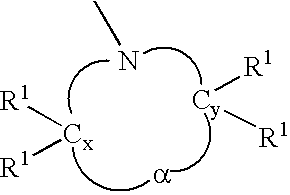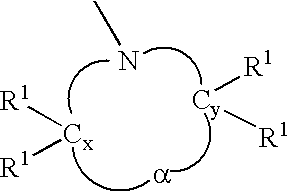Anionic polymerization initiators and polymers therefrom
a technology of initiators and polymers, applied in the field of anionic polymerization initiators and polymers therefrom, can solve the problems of limited solubility of these compounds in solvents, particularly aliphatic solvents, and the inability to predict which compounds are soluble in aliphatic solvents,
- Summary
- Abstract
- Description
- Claims
- Application Information
AI Technical Summary
Problems solved by technology
Method used
Image
Examples
experiment i
[0053] 2-[4-(4-methylpiperazino)]phenyl-1,3-dithiane was prepared by reacting 4-(4-methylpiperazino)benzaldehyde with 1,3-propanedithiol. Specifically, this dithiane was prepared as follows. To an oven-dried 500 ml flask fitted with a magnetic stirring bar and reflux condenser was introduced 9.0 g (44.05 mmol) of 4-(4-methylpiperazino)benzaldehyde, 17.0 g (88.5 mmol) of p-toluenesulfonic acid monohydrate, and 250 ml of THF. The mixture was stirred for 10 minutes, and then added 5.0 g of Montmorillonite KSF (clay supported sulfonic acid), followed by 5 ml (FW=108.23, d=1.078, 48.4 mmol) of 1,3-propanedithiol in 30 ml of THF. The mixture was refluxed under nitrogen for 20 hours. After cooling to room temperature, 12 ml of triethylamine (Et3N) was added and stirred for 1 hour at room temperature, filtrated, the filtrate was washed with KOH (2N), saturated NaHCO3 (2×100 ml), saturated NaCl (2×100 ml) and dried over MgSO4 (anhydrous). The solvent was evaporated; the residue was chromatog...
experiment ii
[0054] Five distinct polymer samples were prepared by initiating the polymerization of butadiene and styrene with a lithiated dithiane initiator that was prepared by lithiating the dithiane compounds prepared in Experiment I in situ. Each polymer sample was terminated with a different terminating agent selected from (i) tributyltin chloride (TBTCl), (ii) 1,3-dimethyl-2-imidazolidinone (DMI), (iii) hexamethylcyclotrisiloxane (D3), (iv) 1-(3-bromopropyl)-2,2,5,5-tetramethyl-1-aza-2,5-disilacyclopentane (PABr), and (v) isopropanol (i-PrOH).
[0055] Specifically, the polymer samples were prepared and isolated as follows. To a two gallon N2 purged reactor equipped with a stirrer was added 2.176 kg of hexane, 0.330 kg of 33 weight percent styrene in hexane, and 1.979 kg of 22.0 weight percent butadiene in hexane. The reactor was then charged with a mixed solution of 1.54 g of 2-[4-(4-methylpiperazino)phenyl-1,3dithiane in 10 ml of THF and 1 ml of triethylamine with 3.0 ml of n-BuLi (1.54M)...
experiment iii
[0056] A control polymer sample was prepared by initiating the polymerization of butadiene and styrene in a similar fashion to Experiment II except that n-butyllithium was employed without a dithiane. The characteristics of the resulting control polymer are set forth in Tables II and IV.
PUM
| Property | Measurement | Unit |
|---|---|---|
| Temperature | aaaaa | aaaaa |
| Time | aaaaa | aaaaa |
| Molar density | aaaaa | aaaaa |
Abstract
Description
Claims
Application Information
 Login to View More
Login to View More - R&D
- Intellectual Property
- Life Sciences
- Materials
- Tech Scout
- Unparalleled Data Quality
- Higher Quality Content
- 60% Fewer Hallucinations
Browse by: Latest US Patents, China's latest patents, Technical Efficacy Thesaurus, Application Domain, Technology Topic, Popular Technical Reports.
© 2025 PatSnap. All rights reserved.Legal|Privacy policy|Modern Slavery Act Transparency Statement|Sitemap|About US| Contact US: help@patsnap.com



